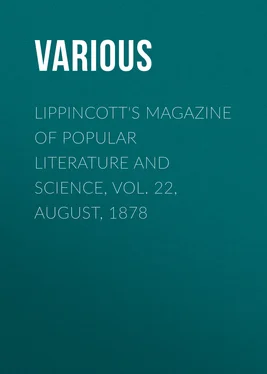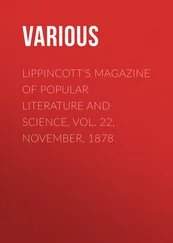Various - Lippincott's Magazine of Popular Literature and Science, Vol. 22, August, 1878
Здесь есть возможность читать онлайн «Various - Lippincott's Magazine of Popular Literature and Science, Vol. 22, August, 1878» — ознакомительный отрывок электронной книги совершенно бесплатно, а после прочтения отрывка купить полную версию. В некоторых случаях можно слушать аудио, скачать через торрент в формате fb2 и присутствует краткое содержание. Издательство: Иностранный паблик, Жанр: foreign_antique, periodic, foreign_edu, на английском языке. Описание произведения, (предисловие) а так же отзывы посетителей доступны на портале библиотеки ЛибКат.
- Название:Lippincott's Magazine of Popular Literature and Science, Vol. 22, August, 1878
- Автор:
- Издательство:Иностранный паблик
- Жанр:
- Год:неизвестен
- ISBN:нет данных
- Рейтинг книги:4 / 5. Голосов: 1
-
Избранное:Добавить в избранное
- Отзывы:
-
Ваша оценка:
- 80
- 1
- 2
- 3
- 4
- 5
Lippincott's Magazine of Popular Literature and Science, Vol. 22, August, 1878: краткое содержание, описание и аннотация
Предлагаем к чтению аннотацию, описание, краткое содержание или предисловие (зависит от того, что написал сам автор книги «Lippincott's Magazine of Popular Literature and Science, Vol. 22, August, 1878»). Если вы не нашли необходимую информацию о книге — напишите в комментариях, мы постараемся отыскать её.
Lippincott's Magazine of Popular Literature and Science, Vol. 22, August, 1878 — читать онлайн ознакомительный отрывок
Ниже представлен текст книги, разбитый по страницам. Система сохранения места последней прочитанной страницы, позволяет с удобством читать онлайн бесплатно книгу «Lippincott's Magazine of Popular Literature and Science, Vol. 22, August, 1878», без необходимости каждый раз заново искать на чём Вы остановились. Поставьте закладку, и сможете в любой момент перейти на страницу, на которой закончили чтение.
Интервал:
Закладка:
VIEW IN THE PARK OF THE TROCADÉRO, SHOWING THE PAVILIONS OF PERSIA AND SIAM.
The next in order is the United States house, which is plain and commodious; the latch-string would be out, but that the front door is everlastingly open. The style is perhaps to advertise to the world that we have not yet had time to invent an order of architecture or devise anything adapted to our climate, which has extremes utterly unknown to our ancestors in Britain. The building is light and airy, has office-rooms on each floor, and is described by one English paper as "a sort of school-building which combines elegance with usefulness." Another paper states that "it exemplifies the utilitarian notions of our Transatlantic cousins rather than any artistic intent." These comments are as favorable as anything we ourselves can say: we accept the verdict with thanks and think we have got off pretty well. In the squareness of its general lines, with arched windows on the second floor and square tower over the centre, perhaps the architect thought it was Italian. Sixteen coats-of-arms on the outside excite admiration.
The building of Norway and Sweden is a charming cottage of handsome and ample proportions. It has three sections: one of two stories with low-pitched roof, and gable to the street, a middle structure with colonnade, and one of three stories with high-pitched roof. The windows are round-topped, made in an ingenious way, the upper member being an arched piece with sloping ends, to match the springing on the tops of the posts which divide the openings. The horizontal and vertical bands are enriched by carving.
The façade of Italy may be pronounced pretentious and disappointing. It is constructed of various kinds of unpolished marble and terra-cotta panels. A tall archway is flanked by two wings having each two smaller arches, the entablatures of which are enriched, if we must so term it, with gaudy mosaic figures, portraits and heraldic bearings, while the spans of the arches surmount pyramidal groups of emblems, scientific, medical, lyrical and so forth. Red curtains with heavy gilt cords and tassels behind the arches throw the columns with composition (not Composite) capitals and the emblems into high relief. Beneath the centre arch is the armorial bearing of the country. The vestibules display statuary.
Japan has a quaint little house with a very massive gateway of solid timber, flanked by two characteristic fountains of terra-cotta. These represent stumps of trees, with gigantic lily-cups, leaves of water-lilies, and frogs in grotesque attitudes in and around the water.
China has a grotesque house, painted in imitation of octagonal slate-colored bricks, covered with a pagoda-roof full of curves and points. The red door has rows of large knobs and is surmounted by colored and gilded carvings, representing genii probably. The pointed flag has in a yellow field a blue dragon in the later stages of consumption.
Spain has a Moorish building rich in gold and color—a central portion with Italian roof, and two colonnade side-sections flanked by castellated towers. Five forms of arches span the doors and windows, and the artist has contrived to associate all forms of ornament, running from an approach to the Greek fret down through the Arabesque to the Brussels carpet.
Austro-Hungary has a long colonnade of white stone ornamented with black filigree-work and supported by columns in pairs. The entablature is surmounted by a row of statues, and the end-towers have parapets with balustrade. The colonnade, with a chocolate-brown back wall, affords shelter and relief for bronze and marble statuary. At each end of this façade is a tall flagstaff striped like a barber's pole, and so familiar to all who have visited the Austrian stations, at Trieste, for example. From it flies the flag of horizontal stripes of red, white and green, with the shield of many quarterings and two angelic supporters.
Russia has a log-and-frame house of somewhat more than average picturesque character. The projecting centres and wing-towers, the outside staircase, and roofs conical, flat, pyramidal, bulbous and Oriental, give it a miscellaneous toyshop appearance, characteristic perhaps of the mosaic character of the nation. Barge-boards and brackets of various cheap patterns are plentifully strewed over the building.
Passing from the Russian to the Swiss building suggests inevitably Mr. Mantalini's description of his former chères amies : "The two countesses had no outline at all, and the dowager's was a demmed outline." A semicircular archway, over which is a high-flying arch with a roof of six slopes surmounted by a bell-tower and pinnacle roof; on the pillars two lions supporting a red shield with white Greek cross in the field; two wings with flat arches containing gorgeous stained-glass windows. But what avails description? There are twenty-two armorial bearings on the spandrils of the arches, beating the United States by six; but we had only room for the original thirteen, the United States and two more. Oh that they had granted us more space! High up aloft is the motto Un pour tous, tons pour un , which was adopted by the French Commune.
Belgium is pre-eminent in the whole row, if expense determines. This country has about three times as much space in the building as the United States, and has worthily filled it. The Belgian façade on the "Street of Nations" is reputed to have cost nearly as much as the whole appropriation made by Congress for the United States exhibit. It is of dark red brick with gray stone quoins and corners and blue and gray marble pillars. The centre building is joined by two colonnades to a flanking tower at one end and an ornate gable at the other. The style is one familiar in the times when the great William of Orange was alive, and was to some extent introduced into England soon after another William took the place of his bigoted father-in-law. It cannot be denied that the general effect is gray, sombre and uncomfortable—that it is too much crowded with objects, and, though of admirable and enduring materials, suggests a spasmodic attempt to assimilate itself to the gala character of the occasion which called it forth. It is the saturnine one of the row. It is said that the pieces are numbered for re-erection in some other place.
Greece has an Athenian house painfully crude in color, white picked out with all the hues of the rainbow and some others, suggesting muddy coffee and chibouques.
Denmark has about twenty feet of front, utilized by a gable-end of brick with facings of imitation stone.
The Central American States have about sixty feet of yellow front, with three arched openings into the vestibule, which is flanked by a tower and a gable.
Anam, Persia, Siam, Morocco and Tunis have unitedly a gingerbread affair of four distinct patterns—we cannot call them styles. Siam in the centre has a chocolate-colored tower picked out with silver, and surmounted by a triple pagoda roof, whence floats the flag, a white elephant in a red field. The six feet of homeliness belonging to Tunis has a balcony of wood which neither reveals nor hides the almond-eyed whose supposed relatives are selling trumpery in booths on the other side of the Seine.
Luxembourg, Andorra, Monaco and San Marino unite in a façade representing the different styles of architecture which prevail in the several states: 1. A portion faintly suggesting the ancient palace of Luxembourg, to-day the residence of Prince Henry of Holland; 2. An entrance erected by the principality of Monaco as the model of that of the royal palace; 3. A window contributed by San Marino, and showing that the prevalent type in the little republic is more useful than ornamental; 4. A balustrade surmounting the façade, supplied by the republic of Andorra.
Portugal has an imitation in cream-colored plaster of a Gothic church-entrance, and a highly-enriched arch with flanking towers, whose canopied niches have figures of warriors and wise men.
Читать дальшеИнтервал:
Закладка:
Похожие книги на «Lippincott's Magazine of Popular Literature and Science, Vol. 22, August, 1878»
Представляем Вашему вниманию похожие книги на «Lippincott's Magazine of Popular Literature and Science, Vol. 22, August, 1878» списком для выбора. Мы отобрали схожую по названию и смыслу литературу в надежде предоставить читателям больше вариантов отыскать новые, интересные, ещё непрочитанные произведения.
Обсуждение, отзывы о книге «Lippincott's Magazine of Popular Literature and Science, Vol. 22, August, 1878» и просто собственные мнения читателей. Оставьте ваши комментарии, напишите, что Вы думаете о произведении, его смысле или главных героях. Укажите что конкретно понравилось, а что нет, и почему Вы так считаете.












